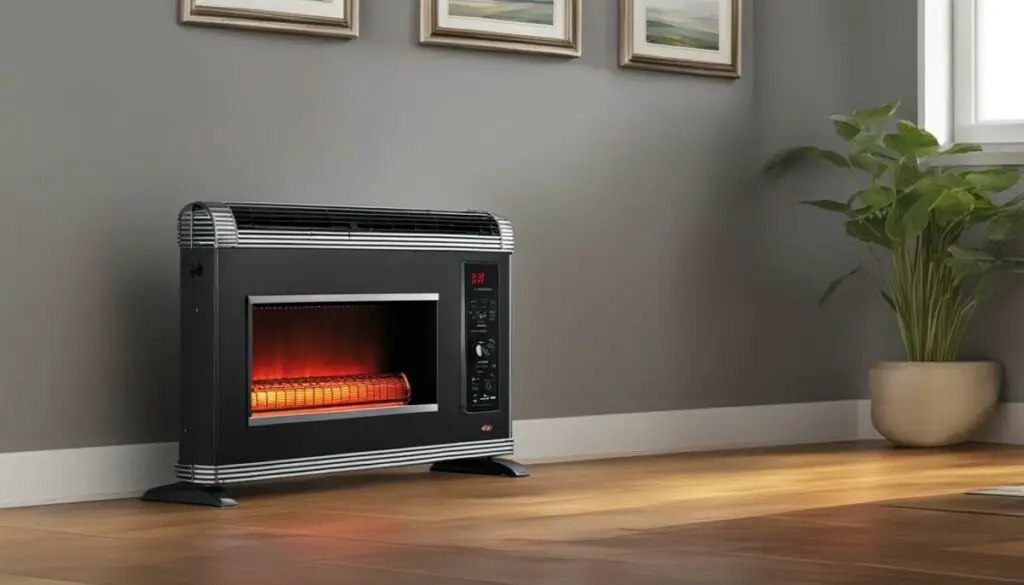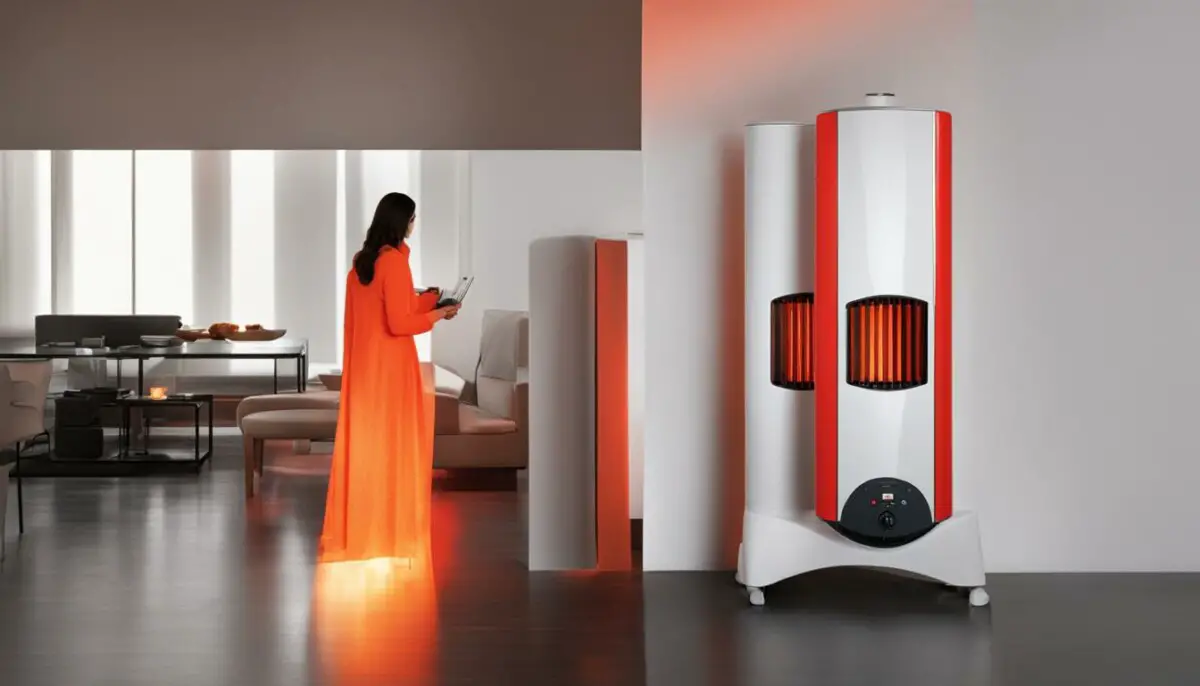Last Updated on 5 months by Francis
When it comes to choosing a heater, the decision between an infrared heater and a convection heater can be daunting. Both options have their advantages and considerations to keep in mind. Infrared heaters use infrared radiation to directly heat objects and people, while convection heaters warm up the air in a room. To help you make an informed decision, let’s compare these two types of heaters based on price, cost to run, type of heat, noise, safety, and installation options.
Contents
Key Takeaways:
- Choosing between an infrared heater and a convection heater depends on factors such as price, cost to run, type of heat, noise, safety, and installation options.
- Infrared heaters tend to be more cost-effective in the long run due to their energy efficiency and ability to retain heat even after being turned off.
- In terms of running costs, infrared heaters are more energy-efficient and consume less electricity compared to convection heaters.
- Convection heaters warm up the air in a room, while infrared heaters provide a more direct and durable heat that doesn’t get lost even in the presence of a cold breeze.
- Both infrared and convection heaters are generally silent during operation, although convection heaters with fans may produce slightly more noise.
Price Comparison

When considering the price of infrared and convection heaters, it is important to take into account both the upfront cost and the long-term cost-effectiveness. Convection heaters generally have a lower initial price compared to infrared heaters. However, infrared heaters offer advantages that make them more cost-effective in the long run.
Although the upfront cost of infrared heaters may be higher, they are more energy-efficient than convection heaters. This means that they consume less electricity, resulting in lower utility bills over time. Additionally, infrared heaters have the ability to retain heat even after being turned off, allowing for further energy savings. Therefore, while infrared heaters may require a larger investment initially, they can provide significant savings in the long term.
In summary, while convection heaters may be more affordable upfront, infrared heaters offer long-term cost-effectiveness through their energy efficiency and heat retention capabilities. It is important to consider your budget and long-term savings goals when making a decision between the two.
| Infrared Heaters | Convection Heaters | |
|---|---|---|
| Upfront Cost | Higher | Lower |
| Long-term Cost-effectiveness | More cost-effective due to energy efficiency and heat retention | Less cost-effective due to higher electricity consumption |
Cost to Run

When comparing infrared and convection heaters, one important factor to consider is the cost to run. The cost of running a heater can have a significant impact on your utility bills, so it’s essential to choose an option that is both efficient and cost-effective. Let’s take a closer look at the cost to run each type of heater.
Benefits of Infrared Heaters
Infrared heaters are known for their energy efficiency, making them an excellent choice for those looking to minimize their energy costs. These heaters use infrared radiation to directly heat objects and people in a room, rather than heating the air. This targeted heating reduces energy waste and ensures that heating is focused where it is needed most. As a result, infrared heaters consume less electricity and are more cost-effective in the long run.
Benefits of Convection Heaters
Convection heaters, on the other hand, heat the air in a room, creating a convection current that circulates warm air throughout the space. While these heaters are generally more affordable upfront, they tend to be less energy-efficient compared to infrared heaters. Convection heaters rely on continuously heating the air, which can lead to higher energy consumption and increased costs over time.
Comparison
| Infrared Heater | Convection Heater | |
|---|---|---|
| Energy Efficiency | High | Lower |
| Electricity Consumption | Less | More |
| Cost-effectiveness | Cost-effective in the long run | Higher running costs over time |
Based on the comparison, infrared heaters have the advantage when it comes to cost to run. While they may have a higher initial price, their energy efficiency and lower electricity consumption make them a more cost-effective option in the long term.
Type of Heat
When it comes to the type of heat generated, infrared heaters and convection heaters differ significantly. Convection heaters work by heating the air in a room, creating convection currents that circulate warm air throughout the space. On the other hand, infrared heaters emit infrared radiation that directly warms objects and people in its path. This fundamental difference in heat distribution affects the efficiency and effectiveness of each type of heater.
Infrared heaters offer a more targeted and efficient heating method. By directly heating objects and people, infrared heaters do not waste energy heating the entire air volume of a room. This focused heat delivery ensures that occupants experience warmth quickly and efficiently, without having to wait for the air in the room to warm up. Additionally, infrared heat stays in the room even if there are drafts or open doors, making it particularly suitable for areas with poor insulation or high ventilation.
Convection heaters, on the other hand, provide more uniform heating throughout the room. The warm air generated by the heater rises and displaces the cooler air, creating a convection current that circulates heat. This type of heat distribution is beneficial in larger, enclosed spaces where maintaining a consistent temperature throughout the room is important. However, it is worth noting that convection heaters may struggle to maintain the desired temperature in rooms with drafts or poor insulation, as the warm air can easily escape.
Comparison of Infrared and Convection Heaters
| Aspect | Infrared Heaters | Convection Heaters |
|---|---|---|
| Heat Distribution | Directly warms objects and people | Heats the air in the room |
| Efficiency | Targeted heat delivery, less energy wasted | Uniform heating throughout the room |
| Heat Retention | Heat stays in the room, even in the presence of drafts | May struggle to maintain temperature in rooms with poor insulation |
When deciding between infrared and convection heaters, it is essential to consider the specific heating needs of your space. If you require quick and efficient warmth that directly heats objects and people, an infrared heater may be the better choice. On the other hand, if you prioritize uniform heating throughout a room and have a well-insulated space, a convection heater may be more suitable. Assessing the type of heat each heater provides is crucial in making an informed decision that meets your heating requirements.
Noise Comparison
When it comes to noise levels, both infrared and convection heaters are generally quiet during operation. However, there can be a slight difference in noise levels depending on the specific model and functionality.
Infrared heaters are known for their silent operation. They typically do not require any fans or moving parts, which means there is no noise generated from the heater itself. This makes them an ideal choice for those who prefer a quiet and peaceful environment.
On the other hand, some convection heaters may produce a slight amount of noise. This is often due to the presence of a fan or blower that helps circulate the warm air throughout the room. While the noise level is usually low and not disruptive, it is important to consider this factor if you are sensitive to background noise or prefer absolute silence.
Table: Noise Comparison
| Heater Type | Noise Level |
|---|---|
| Infrared Heater | Quiet (virtually silent) |
| Convection Heater | Low noise (due to fan/blower) |
Overall, both infrared and convection heaters provide a relatively quiet heating experience. However, if you prioritize a noise-free environment, infrared heaters are the better choice as they do not produce any noticeable sound during operation.
Safety Considerations
When considering which type of heater to choose, safety should be a top priority. Both infrared and convection heaters come with built-in safety features to prevent overheating and accidents. However, it’s important to understand the specific safety considerations for each type of heater.
One advantage of infrared heaters is that they typically have ceramic infrared panels, which are considered the safest option. These panels are resistant to voltage fluctuations and do not overheat, reducing the risk of fire or electrical hazards. Additionally, infrared heaters do not produce any harmful emissions, making them a safe choice for indoor use. However, as with any electrical appliance, it’s still important to follow manufacturer instructions and avoid placing flammable objects near the heater.
Convection heaters also have safety features in place, but they may not have the same level of safety as infrared heaters. Some convection heaters may become hot to the touch, posing a burn risk, especially for curious children or pets. It’s crucial to keep these heaters out of reach and supervise their use in households with young children or pets. Additionally, convection heaters that use a fan to circulate warm air may have moving parts that could cause injury if mishandled.
To ensure the safety of your household, it’s important to carefully consider the specific safety features and risks associated with both infrared and convection heaters. Choose a heater that aligns with your safety requirements and follow all safety guidelines provided by the manufacturer.
Installation Options

Infrared heaters offer a range of installation options, making them versatile and adaptable to different spaces. One popular option is wall-mounted panels, which blend seamlessly into the surroundings and free up valuable floor space. These panels can be installed at the optimal height for effective heating and can even double as mirrors or wall art, adding both functionality and aesthetics to a room.
Convection heaters, on the other hand, are more traditional in their installation. They are typically designed to be placed on the floor or mounted on wheels for easy mobility. This means that they may take up valuable floor space and can limit furniture arrangement options. However, they are generally straightforward to set up and can be moved around as needed.
Ultimately, the choice between infrared and convection heaters in terms of installation options depends on your specific needs and preferences. If you value space efficiency and a seamless integration into your existing décor, infrared heaters with their wall-mounted panels might be the ideal choice. However, if you prefer the flexibility of portability and ease of setup, convection heaters are a reliable option.
| Installation Options | Infrared Heaters | Convection Heaters |
|---|---|---|
| Mounting | Wall-mounted panels | Placed on the floor or mounted on wheels |
| Space Efficiency | Does not take up floor space | May occupy floor space |
| Versatility | Can double as mirrors or wall art | Portable and easy to move |
Control and Ease of Use

When it comes to the control and ease of use, both infrared and convection heaters offer different features and options to consider. Convection heaters typically provide more control options, including timers and programmable settings. These advanced controls allow users to schedule the heating cycles and adjust the temperature according to their preferences. On the other hand, infrared heaters usually have simpler controls with limited settings, often consisting of a power switch and a temperature dial. This straightforward design makes them easy to operate, especially for those who prefer a more intuitive and hassle-free experience.
While convection heaters may offer more versatility in terms of control options, it’s important to consider whether these added features are necessary for your specific requirements. Some users might find the simplicity of infrared heaters appealing, as they eliminate the need for complex programming or constant adjustments. Ultimately, the choice between the two types of heaters depends on your personal preferences and desired level of control over the heating process.
Infrared vs Convection Heaters: Pros & Cons
When deciding between infrared and convection heaters, it’s important to weigh the pros and cons of each option. Here’s a breakdown of the advantages and disadvantages of both types:
Pros of Infrared Heaters:
- Efficient heating: Infrared heaters deliver heat directly to objects and people, resulting in quick and targeted warmth.
- Energy savings: These heaters consume less electricity and are more energy-efficient, helping to reduce long-term utility costs.
- Instant heat: Infrared heaters provide immediate warmth without the need for preheating, making them ideal for quick comfort.
- No noise: Infrared heaters typically operate silently, ensuring a peaceful and quiet environment.
- Safe operation: With safety features to prevent overheating and voltage fluctuations, infrared heaters are a reliable and secure heating option.
- Versatile installation: They offer various installation options, including wall-mounted panels that blend seamlessly into any space.
Cons of Infrared Heaters:
- Higher upfront cost: Infrared heaters generally have a higher initial price compared to convection heaters.
- Limited control options: These heaters often have simpler controls and fewer settings, offering less customization for temperature adjustments.
- Spot heating: Infrared heaters may not heat an entire room evenly, focusing on heating specific areas directly in front of the unit.
Pros of Convection Heaters:
- Lower initial cost: Convection heaters are generally more affordable upfront, making them a budget-friendly option.
- Even heat distribution: They warm up the air in a room, ensuring consistent heat throughout the space.
- More control options: Convection heaters often come with programmable settings and timers, allowing for precise temperature regulation.
- Wide coverage: These heaters can efficiently heat larger areas, making them suitable for spacious rooms or open-concept living spaces.
Cons of Convection Heaters:
- Higher energy consumption: They tend to use more electricity than infrared heaters, resulting in potentially higher long-term operating costs.
- Potential noise: Convection heaters that utilize a fan for air circulation may produce some noise during operation.
- Slower heating: Compared to infrared heaters, convection heaters may take longer to reach the desired temperature.
- Space requirements: These heaters usually take up floor space and may limit furniture arrangement options.
Consider your specific needs, budget, and preferences when choosing between infrared and convection heaters. Both options have their pros and cons, so selecting the right heater for your space will ensure optimal comfort and efficient heating.
What’s Best For…
When it comes to choosing between infrared and convection heaters, the best option depends on your specific needs and preferences. Both types of heaters offer their own set of benefits and considerations. Let’s take a look at who might benefit most from each:
Benefits of Infrared Heaters:
- People who want direct, instant heat: Infrared heaters emit heat that warms objects and people directly, providing immediate warmth.
- Individuals looking for energy efficiency: Infrared heaters are known for their energy efficiency, consuming less electricity and saving you money on your utility bills.
- Those with enclosed or drafty spaces: Infrared heaters provide a more durable heat that is not easily lost through drafts or open doors, making them suitable for spaces with minimal ventilation.
- Homeowners concerned about safety: Infrared heaters, particularly those with ceramic panels, are considered safe options that don’t overheat or pose a fire hazard.
Benefits of Convection Heaters:
- Individuals on a budget: Convection heaters generally have a lower upfront cost compared to infrared heaters, making them a more affordable option for those on a tight budget.
- People looking for versatile heating options: Convection heaters warm up the air in a room, making them suitable for larger areas or spaces with better ventilation.
- Those who prefer programmable features: Convection heaters often offer more control options, such as timers and programmable settings, allowing you to customize your heating preferences.
- Individuals with limited installation options: Convection heaters are typically floor-standing units that don’t require any special installation, making them convenient for renters or those who don’t want to mount heaters on their walls.
Consider your specific requirements and priorities when choosing between infrared and convection heaters. Whether you prioritize direct heat, energy efficiency, budget-friendliness, or ease of use, there is a heater option that can meet your needs.
Conclusion
When it comes to choosing between infrared and convection heaters, the decision ultimately boils down to personal preferences and specific needs. By considering factors such as cost, efficiency, type of heat, noise, safety, and installation options, you can make an informed choice that suits your requirements for comfort and warmth.
In terms of price, convection heaters typically have a lower upfront cost, while infrared heaters prove to be more cost-effective in the long run due to their energy efficiency and heat retention capabilities even after being turned off.
When it comes to running costs, infrared heaters emerge as winners as they are more energy-efficient and consume less electricity than convection heaters, resulting in potential savings on your utility bills in the long term.
Both types of heaters have their own advantages and disadvantages. Convection heaters warm up the air in a room, while infrared heaters heat objects and people directly. Convection heaters are suitable for enclosed spaces with minimal ventilation, but the heat may be lost through drafts or open doors. In contrast, infrared heaters provide a more reliable heat that is not easily lost even in the presence of a cold breeze.
It’s important to also consider factors such as noise, safety features, and installation options. While both types of heaters are generally silent during operation, convection heaters with fans may produce slightly more noise. Both infrared and convection heaters come with safety features, but ceramic infrared panels are considered the safest option due to their resistance to voltage fluctuations and overheating. Additionally, infrared heaters offer more installation options, such as wall-mounted panels that can blend into the surroundings or even serve as mirrors or wall art.
In conclusion, there is no definitive answer to whether infrared or convection heaters are better. It ultimately depends on your specific needs and preferences. Take the time to evaluate the different factors and decide which type of heater aligns best with your requirements for comfort, efficiency, and style.
FAQ
Which type of heater is better, infrared or convection?
The decision between infrared and convection heaters depends on factors such as price, cost to run, type of heat, noise, safety, and installation options.
What is the price comparison between infrared and convection heaters?
Convection heaters typically cost less upfront, while infrared heaters are more cost-effective in the long run due to their energy efficiency and ability to retain heat.
What is the cost to run for infrared and convection heaters?
Infrared heaters are more energy-efficient and consume less electricity, resulting in lower utility bills compared to convection heaters.
How do the types of heat differ between infrared and convection heaters?
Convection heaters warm up the air in a room, while infrared heaters heat objects and people directly.
Which type of heater has a noise advantage?
Both infrared and convection heaters are generally quiet, but convection heaters with fans may produce slightly more noise.
What are the safety considerations for infrared and convection heaters?
Both types of heaters have safety features, but ceramic infrared panels are considered the safest option due to their resistance to voltage fluctuations and overheating.
What are the installation options for infrared and convection heaters?
Infrared heaters offer more flexibility with options like wall-mounted panels that can blend into the surroundings, while convection heaters are more traditional and usually take up floor space.
Are there differences in control and ease of use between infrared and convection heaters?
Convection heaters typically offer more control options such as timers and programmable settings, while infrared heaters have simpler controls with limited settings.
What are the pros and cons of infrared and convection heaters?
Both types of heaters have their advantages and disadvantages, which should be considered based on individual needs and preferences.
Which type of heater is best for specific needs?
The best choice between infrared and convection heaters depends on factors such as cost, efficiency, type of heat, noise, safety, and installation options.
What is the conclusion regarding infrared and convection heaters?
Choosing between infrared and convection heaters ultimately comes down to personal preferences and specific needs.



.jpg)





